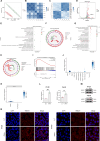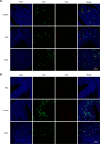Real-world of Limosilactobacillus reuteri in mitigation of acute experimental colitis
- PMID: 39891249
- PMCID: PMC11783912
- DOI: 10.1186/s12951-025-03158-8
Real-world of Limosilactobacillus reuteri in mitigation of acute experimental colitis
Abstract
Probiotics have been proposed as a potential strategy for managing ulcerative colitis (UC). However, the underlying mechanisms mediating microbiota-host crosstalk remain largely elusive. Here, we report that Limosilactobacillus reuteri (L. reuteri), as a probiotic, secretes cytoplasmic membrane vesicles (CMVs) that communicate with host cells, alter host physiology, and alleviate dextran sulfate sodium (DSS)-induced colitis. First, L. reuteri-CMVs selectively promoted the proliferation of the beneficial bacterium Akkermansia muciniphila (AKK) by upregulating the expression of glycosidases (beta-N-acetylhexosaminidase and alpha-N-acetylglucosaminidase) involved in glycan degradation and metabolic pathways and restored the disrupted gut microbiota balance. Second, L. reuteri-CMVs were taken up by intestinal epithelial cells (IECs), elevated the expression of ZO-1, E-cadherin (Cdh1), and Occludin (Ocln), decreased intestinal permeability, and exerted protective effects on epithelial tight junction functionality. RNA sequencing analysis demonstrated that L. reuteri-CMVs repaired intestinal barrier by activating the HIF-1 signaling pathway and upregulating HMOX1 expression. Third, L. reuteri-CMVs increased the population of double positive (DP) CD4+CD8+ T cells in the intestinal epithelial layer, suppressing gut inflammation and maintaining gut mucosal homeostasis. Finally, L. reuteri-CMVs exhibited satisfactory stability and safety in the gastrointestinal tract and specifically targeted the desired sites in colitis mice. Collectively, these findings shed light on how L. reuteri interact with the host in colitis, and provide new insights into potential strategies for alleviating colitis.
Keywords: Limosilactobacillus reuteri; Colitis; Cytoplasmic membrane vesicles; Double positive CD4+CD8+ T cells; Gut microbiota; Intestinal barrier.
© 2025. The Author(s).
Conflict of interest statement
Declarations. Ethics approval and consent to participate: All the animal experiments were approved by the Animal Care Committee of the Shenzhen People’s Hospital, Shenzhen, China (No. 2024-118). Consent for publication: Not applicable. Competing interests: The authors declare no competing interests.
Figures








References
-
- Mars RAT, Yang Y, Ward T, et al. Longitudinal multi-omics reveals subset-specific mechanisms underlying irritable bowel syndrome. Cell. 2020;183:1137–40. - PubMed
-
- Tilg H, Adolph TE, Gerner RR, et al. The intestinal microbiota in Colorectal Cancer. Cancer Cell. 2018;33:954–64. - PubMed
-
- van Nood E, Vrieze A, Nieuwdorp M, et al. Duodenal infusion of donor feces for recurrent Clostridium difficile. N Engl J Med. 2013;368:407–15. - PubMed
MeSH terms
Substances
Supplementary concepts
Grants and funding
LinkOut - more resources
Full Text Sources
Research Materials
Miscellaneous

